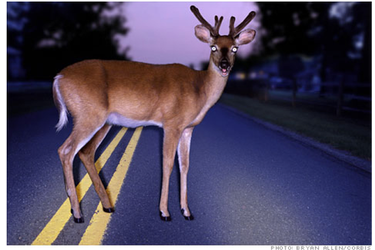Officials Warn of Peak Season for Oklahomans Hitting Deer
KTUL - November 15, 2022 6:35 am

TULSA, Okla. (KTUL) — Oklahomans are more likely to hit a deer with their car right now than any other time of year.
The Oklahoma Highway Safety Office says 836 cars struck deer in 2021, but most deer impacts aren’t reported, so the true number is much higher.
The Mannford Police Department typically sees about a dozen deer strikes per year. Chief Jerry Ridley said they’ve already hit that total.
“I worked one just last week,” added Officer Tristan Warnock. “I’ve worked at least four so far this year.”
“Basically, the does come into heat and the bucks go around chasing the does,” he explained. “And they’ll chase them everywhere. Across lanes of traffic, through people’s yards, through city streets.”
AAA Oklahoma spokesperson Leslie Gamble said the rut makes driving more dangerous through the end of December. She said the end of Daylight Saving Time is also a contributing factor, as people become more likely to commute in the dark.
“Among those 836 crashes reported last year in our state,” she said, “five people died. And more were seriously injured.”
“I’ve seen deer go through windshields,” Warnock added. “I’ve seen busted radiators, front bumpers torn off, airbags deployed. Especially at high speeds on the highway. I mean, you hit a deer going 65 miles per hour, it’ll do some damage.”
“I have seen a couple pretty serious injuries,” he continued, “especially the ones where the deer go through the windshield.”
Mannford Police say the section of State Highway 51 on the city’s eastern border is the most dangerous spot in town. There are no streetlights, there are woods on both sides, and the stretch of road has a 65 mile-per-hour speed limit. It’s a perfect storm for deer impacts.
“In the event that a deer runs out in front of you,” Warnock said, “we encourage you to brake in a straight line.”
Warnock said 20 percent of fatal accidents occur when a car leaves the road and hits a solid object, like a sign or a tree. He also said swerving creates the risk of a rollover collision. Gamble said swerving is one of the most common reactions to seeing deer in the road.
“They’re thinking, ‘here’s the deer, I’m coming up on it, I gotta get over,’” she said. “And they swerve into another lane of oncoming traffic.”
Gamble said newer cars are loaded with safety features. However, the additional sensors and technology make deer impacts more expensive.
“The average cost of a claim filed with AAA insurance last year related to striking an animal was $5,621,” she said, “an increase of $1,000 from two years earlier.”
Warnock said deer prefer to move at night, especially at dusk and dawn, which is why most deer strikes happen when visibility is poor.
“From what I’ve seen,” he said, “the hours of 6 to 9 p.m. are when you’re going to see the most activity on the highways and rural areas.”
Both Mannford Police and AAA Oklahoma admitted it’s hard to avoid a deer in the middle of the road. But they both said the best thing people can do to protect themselves is wear a seatbelt.



